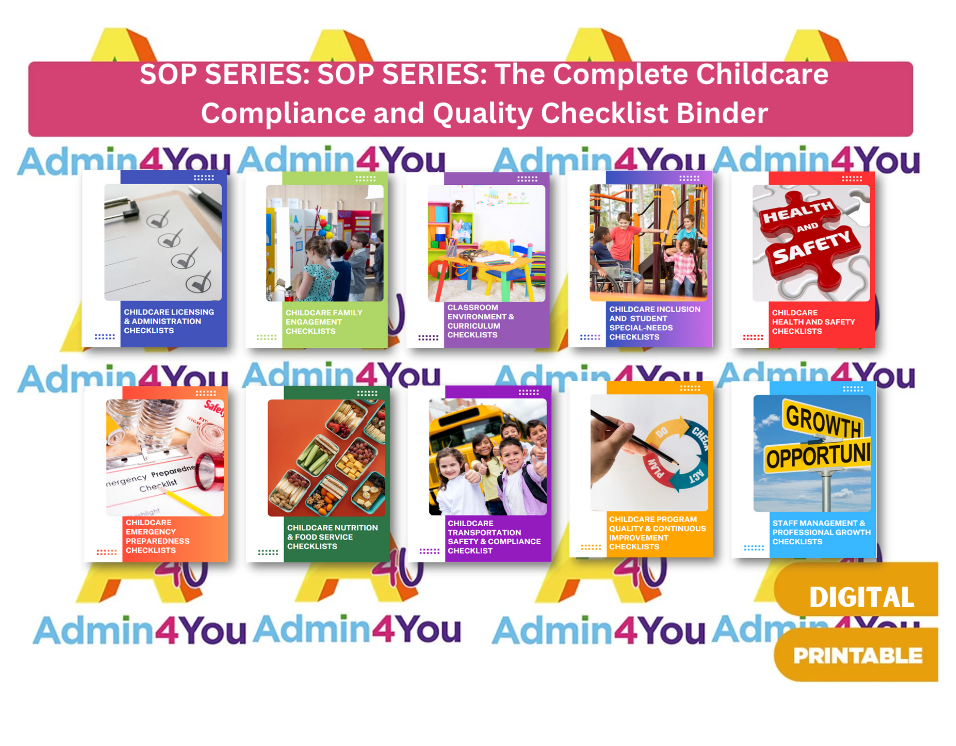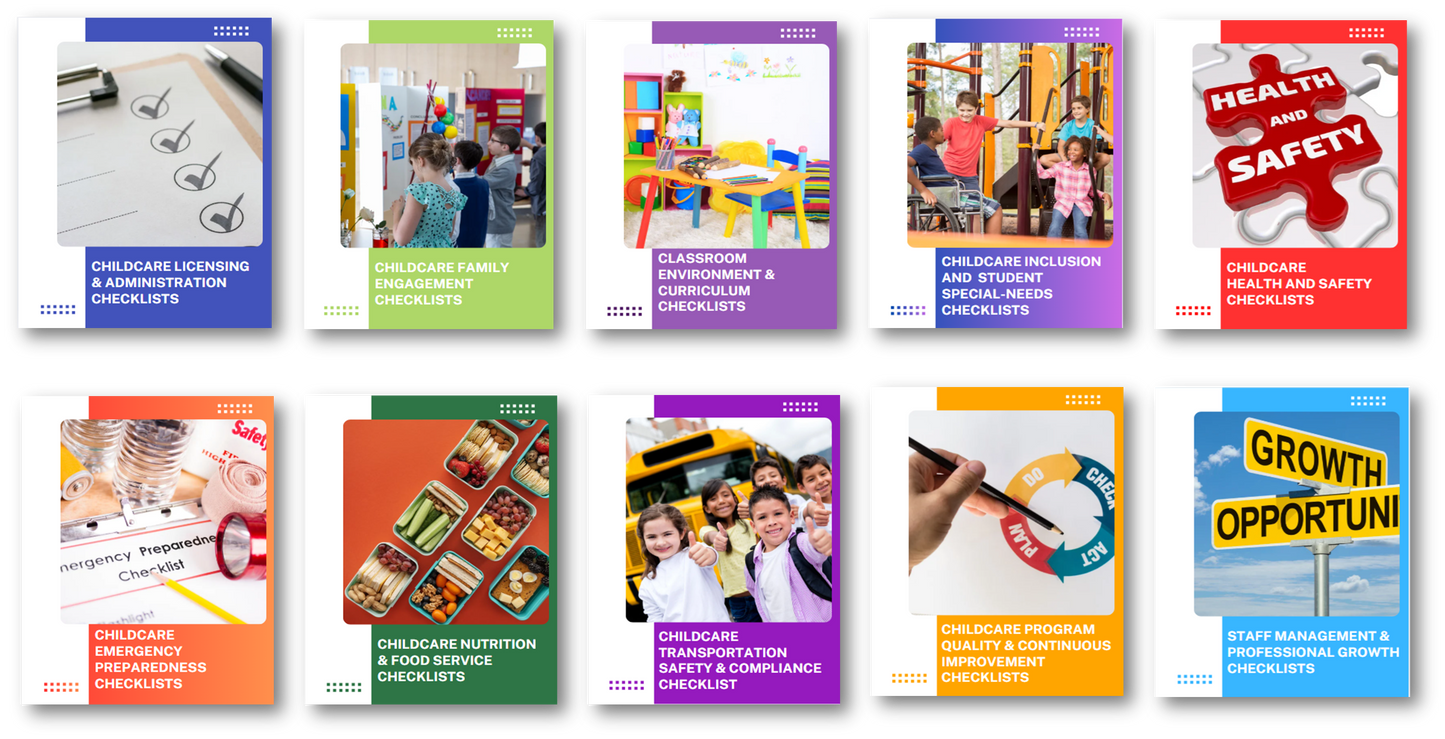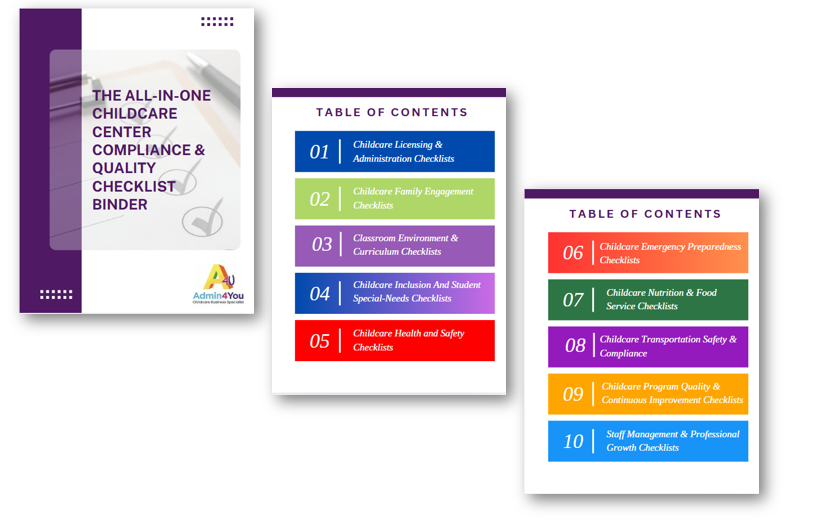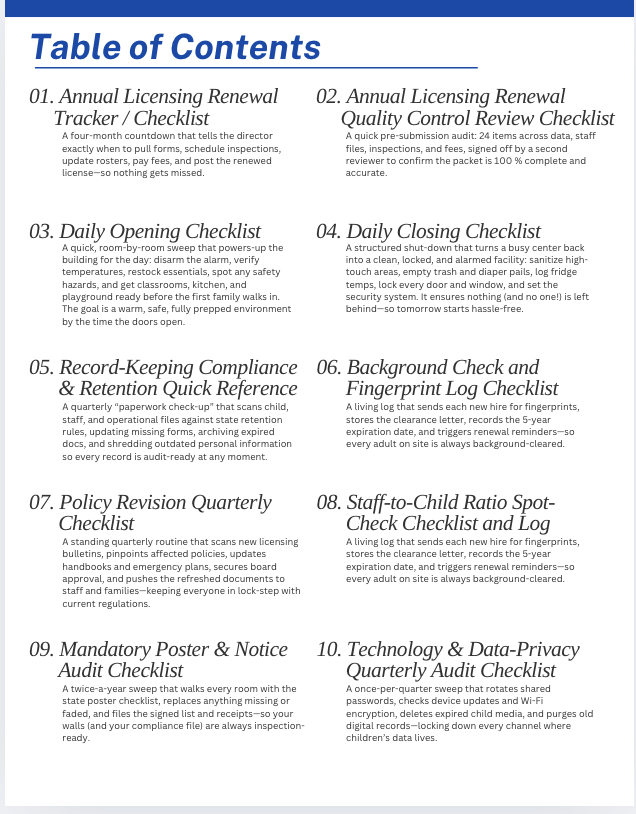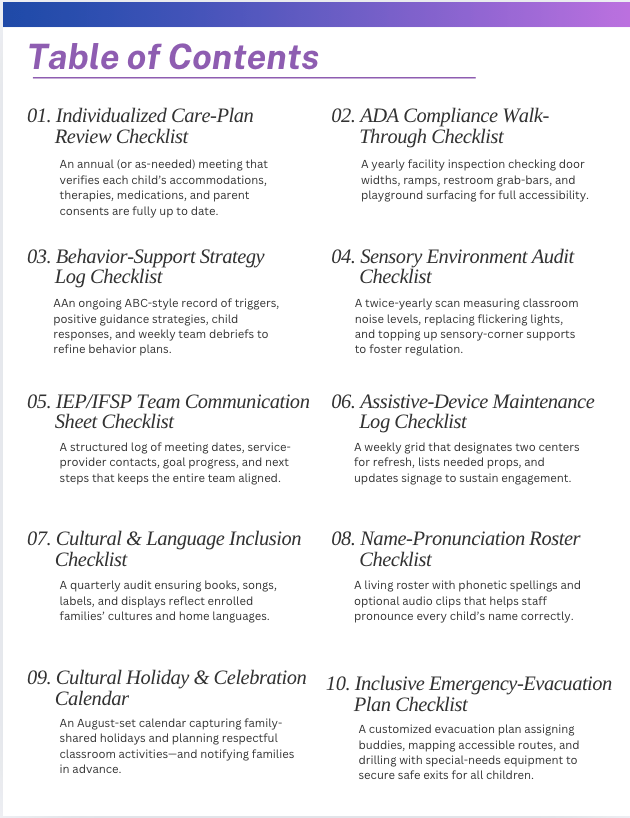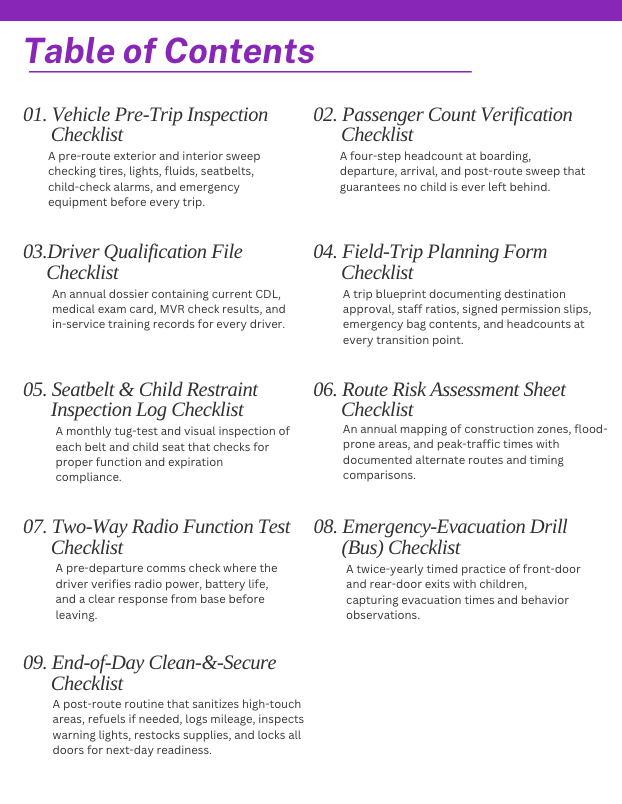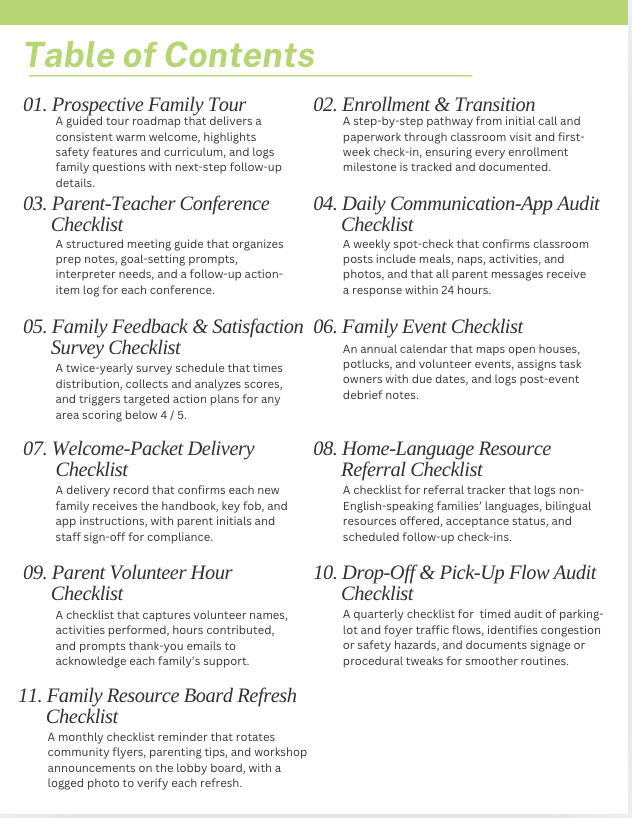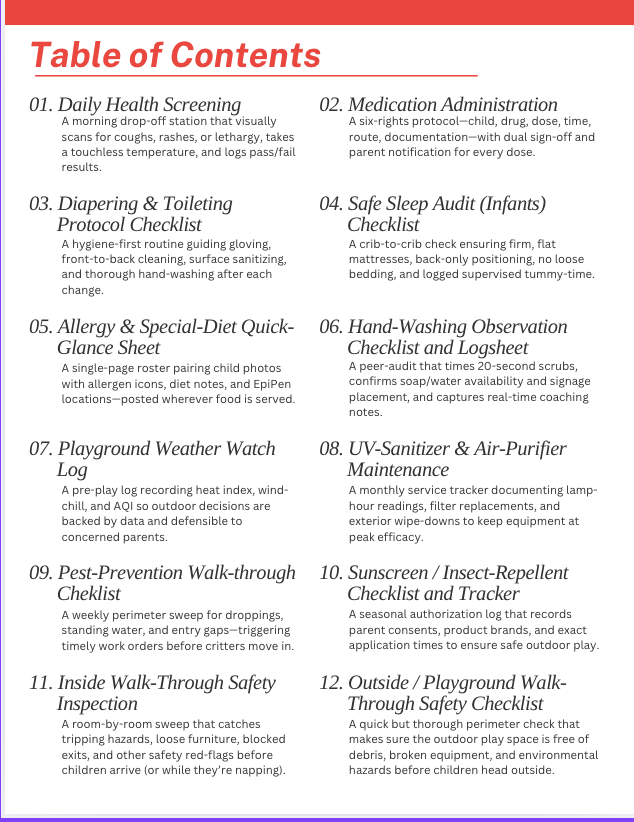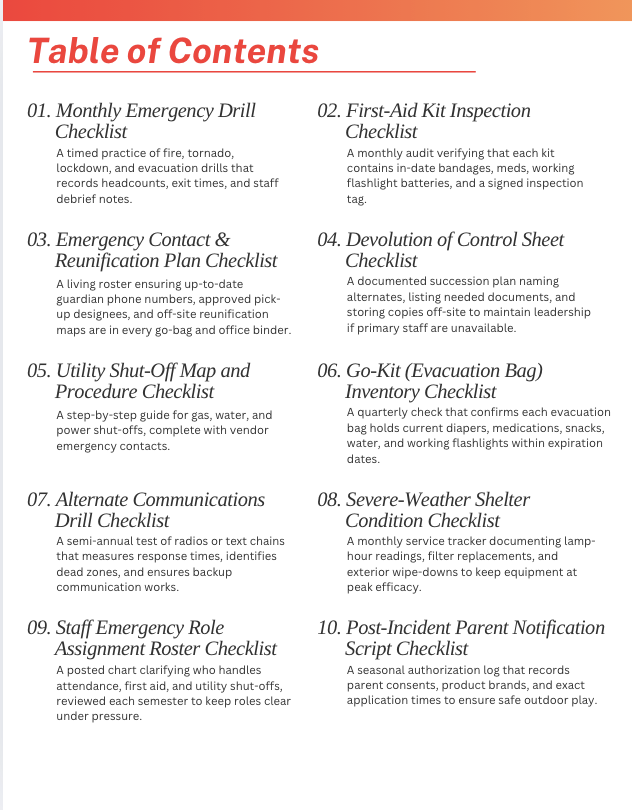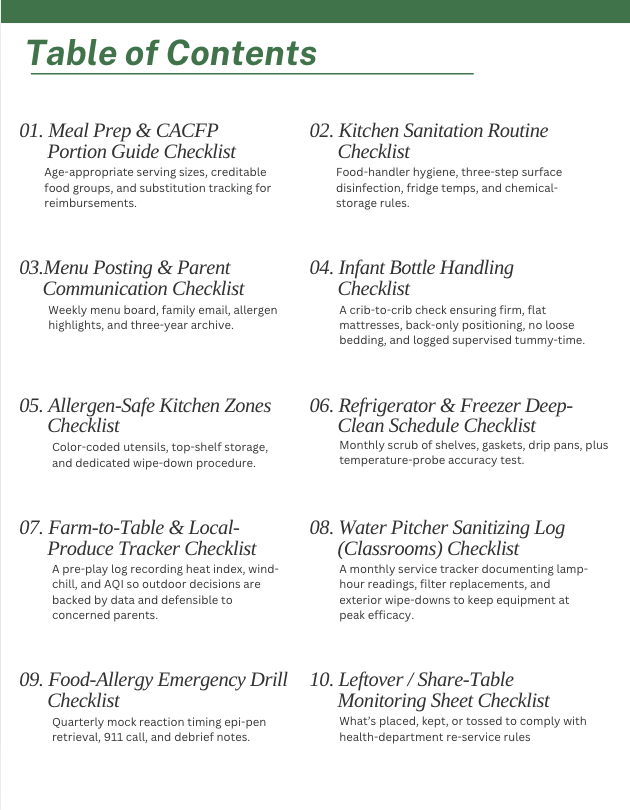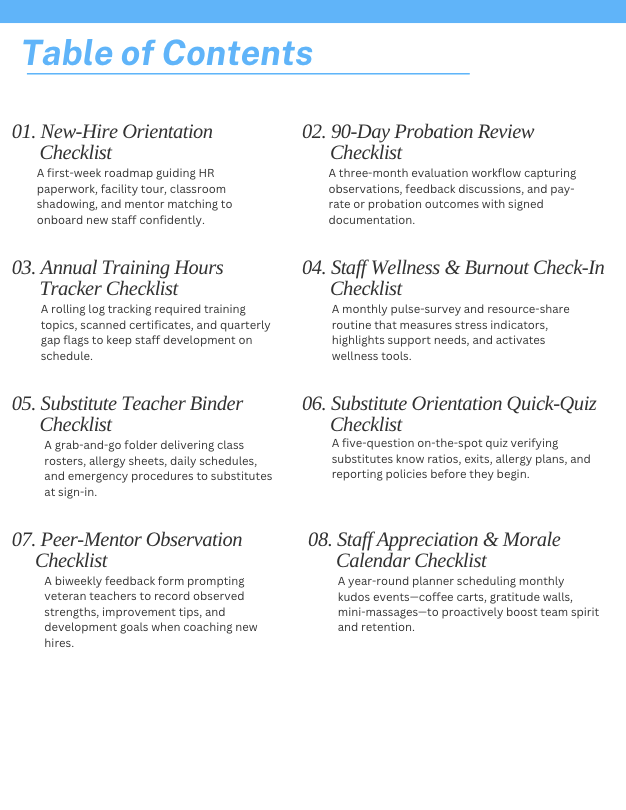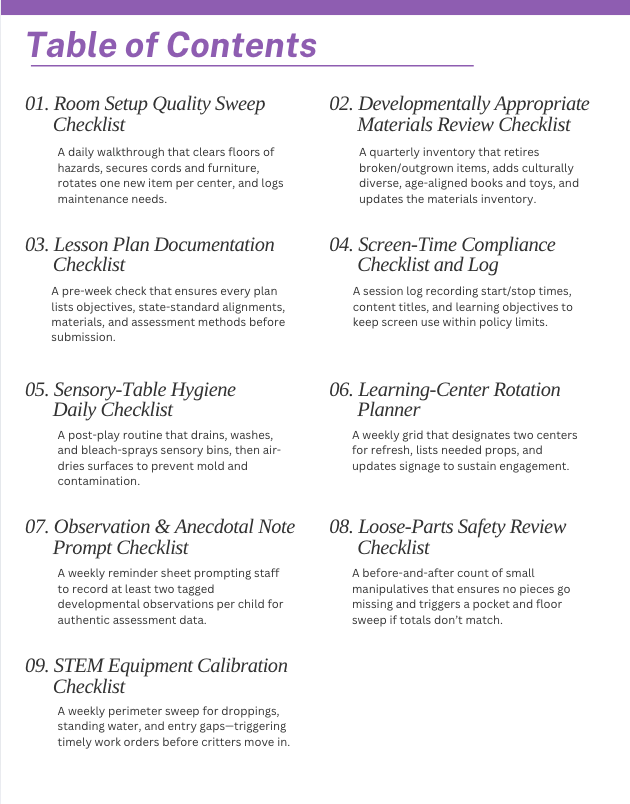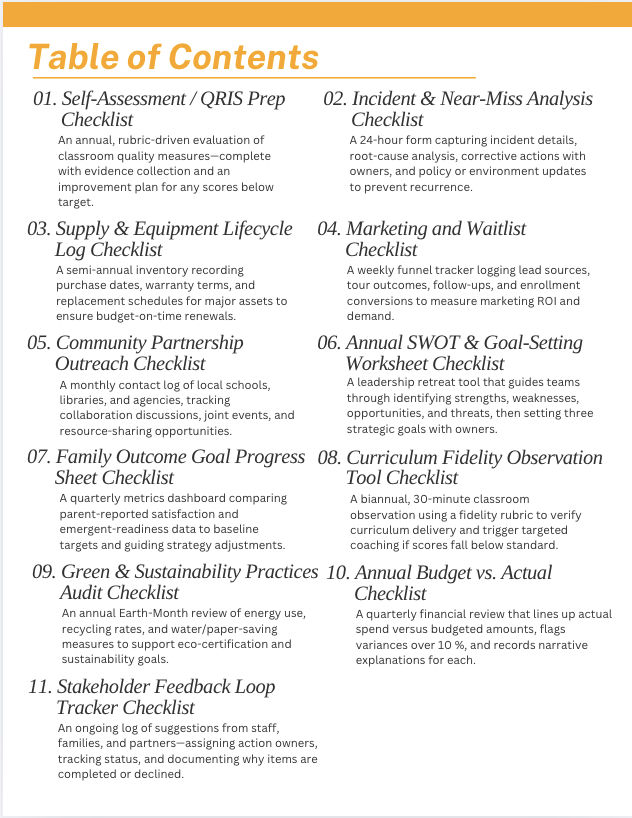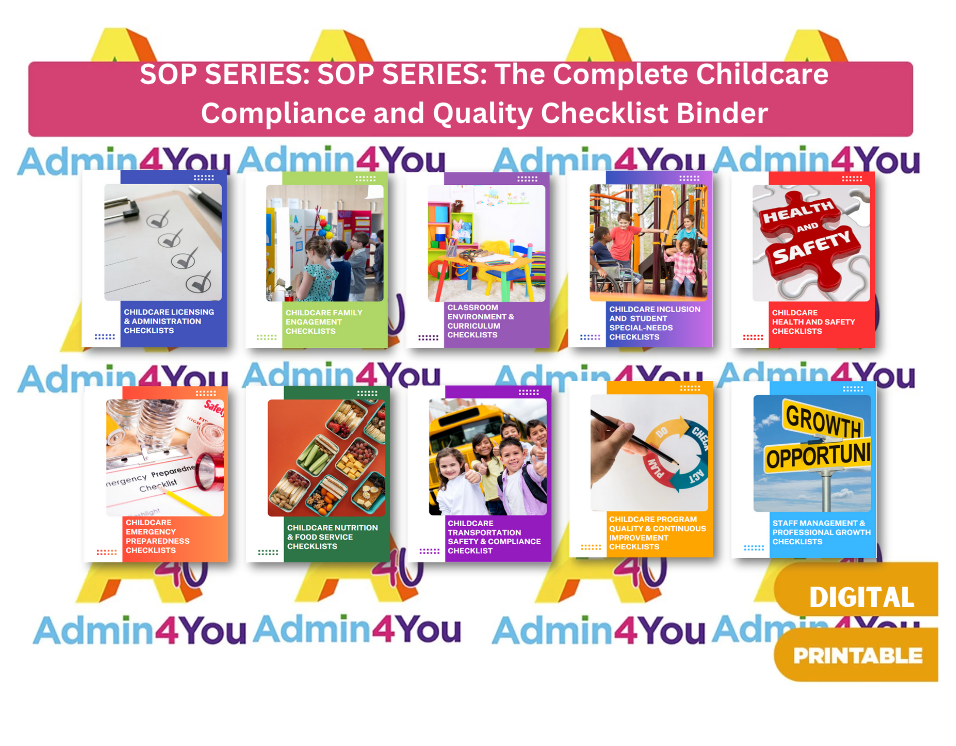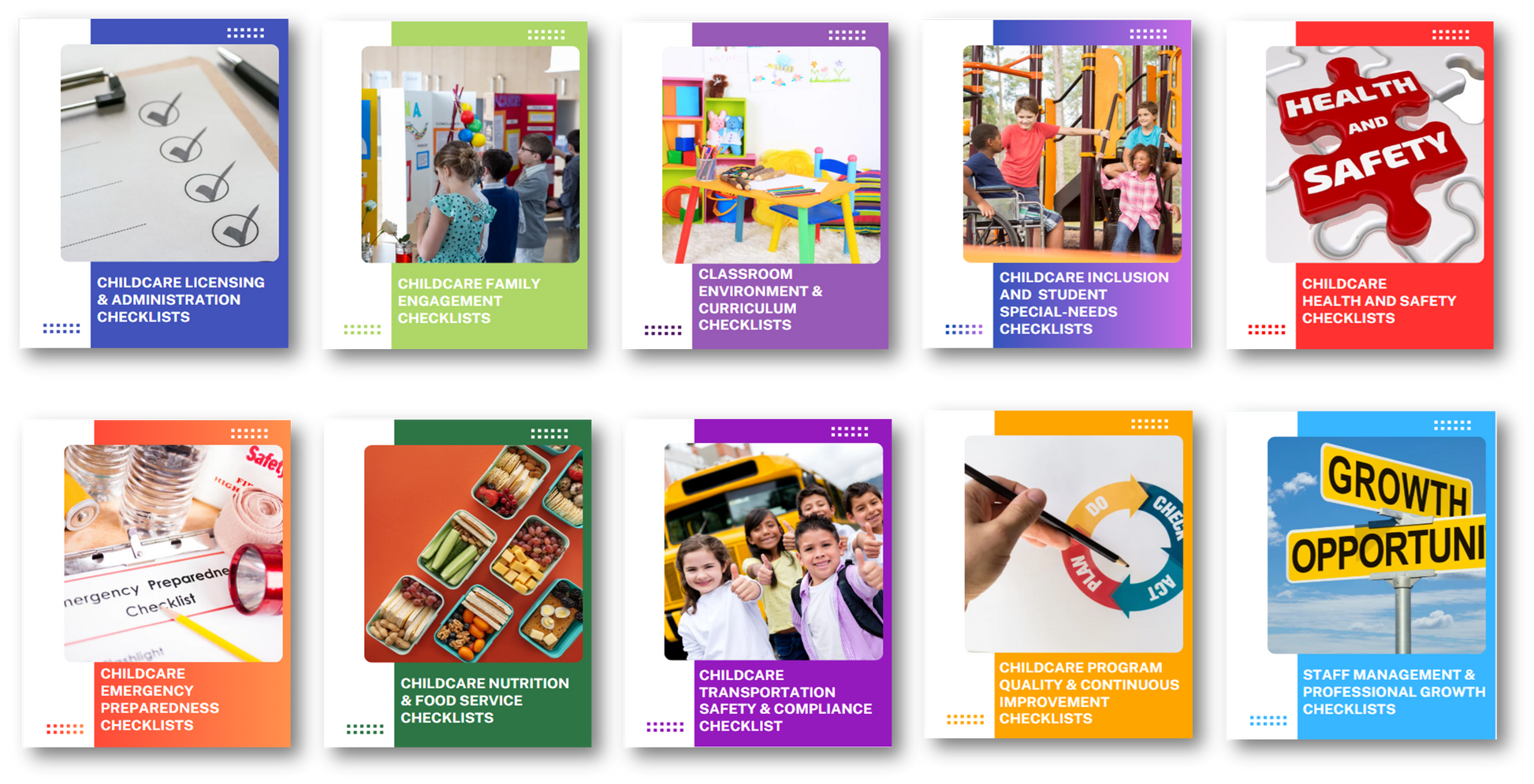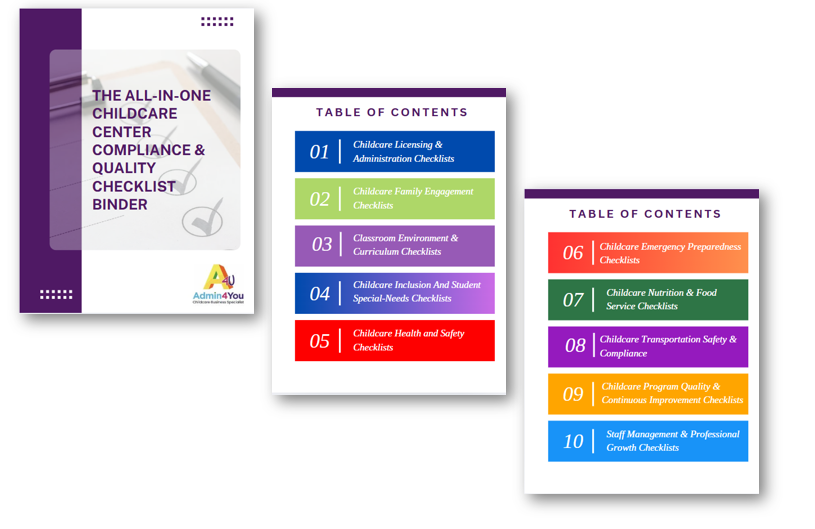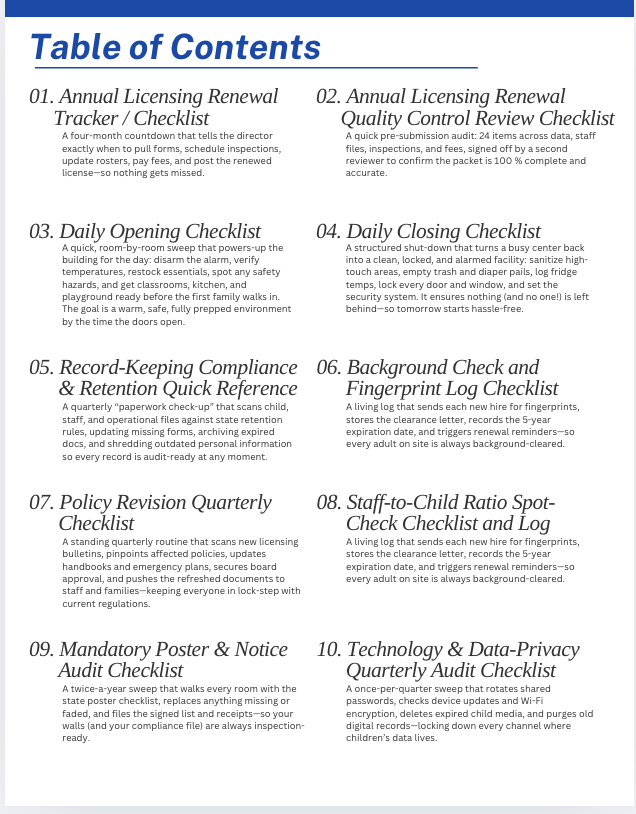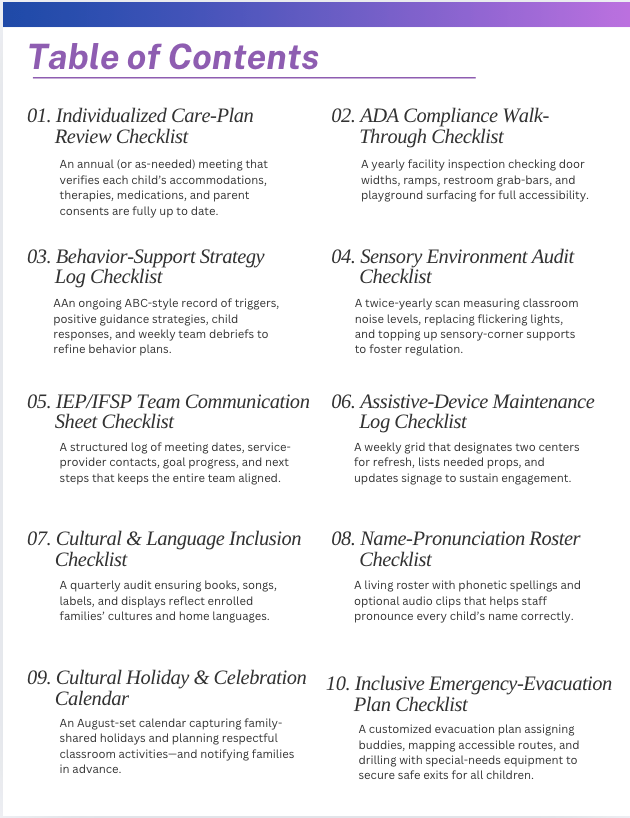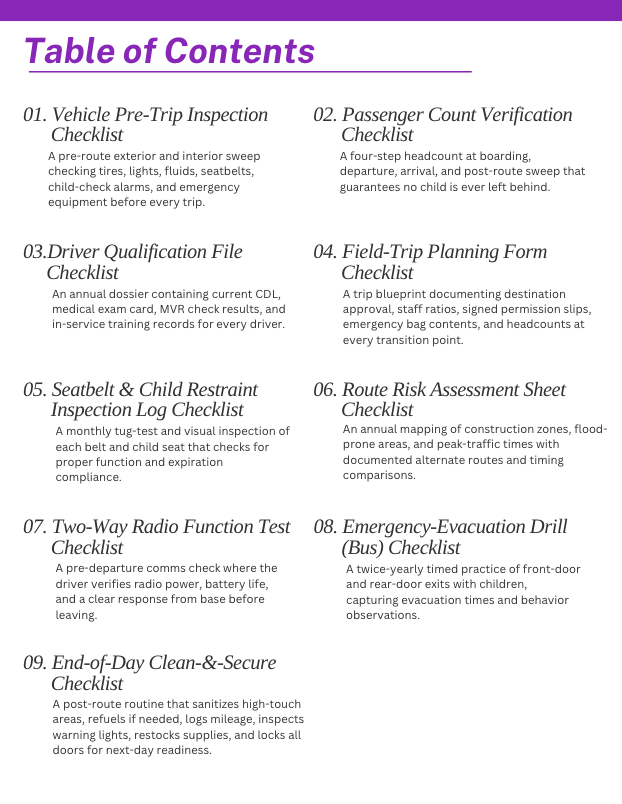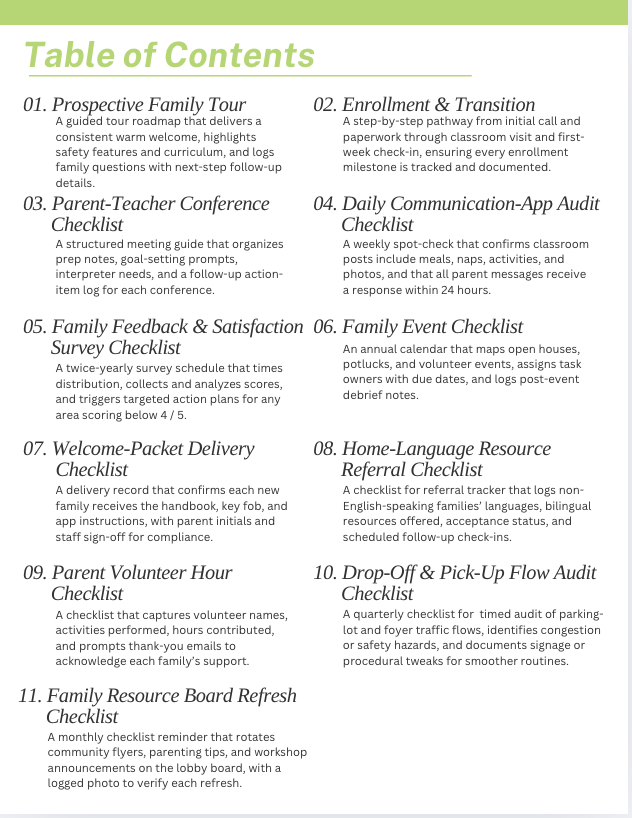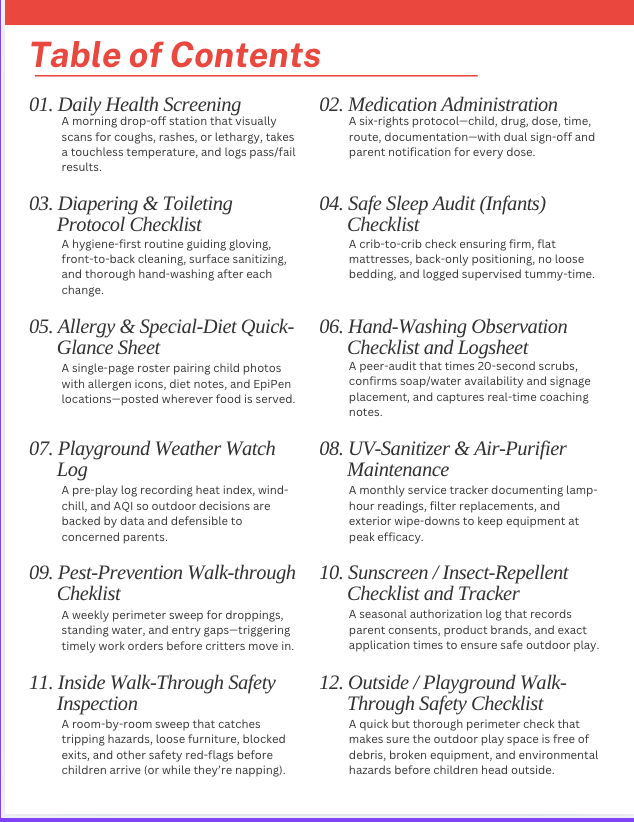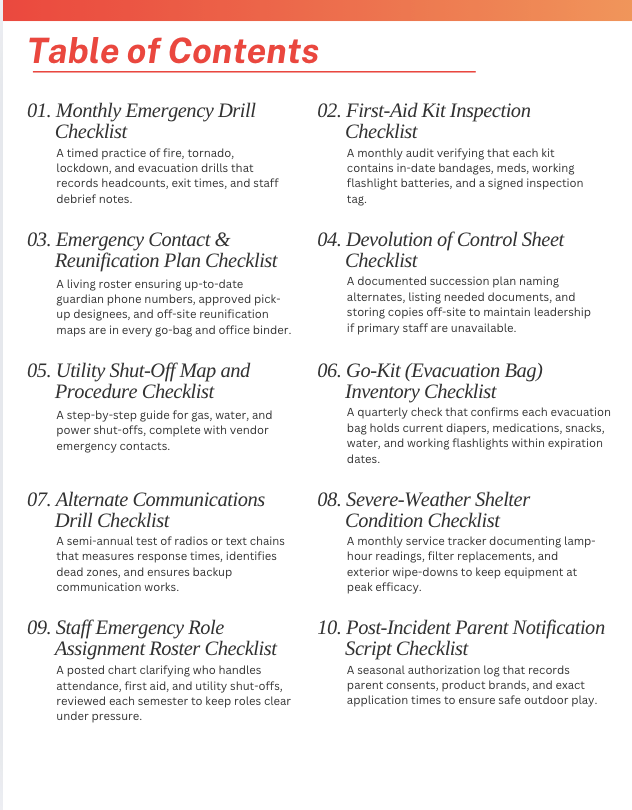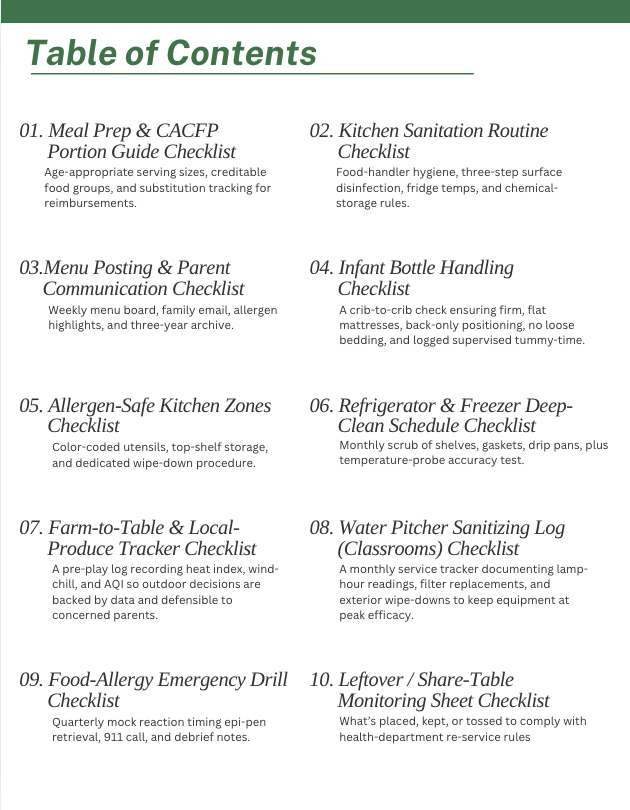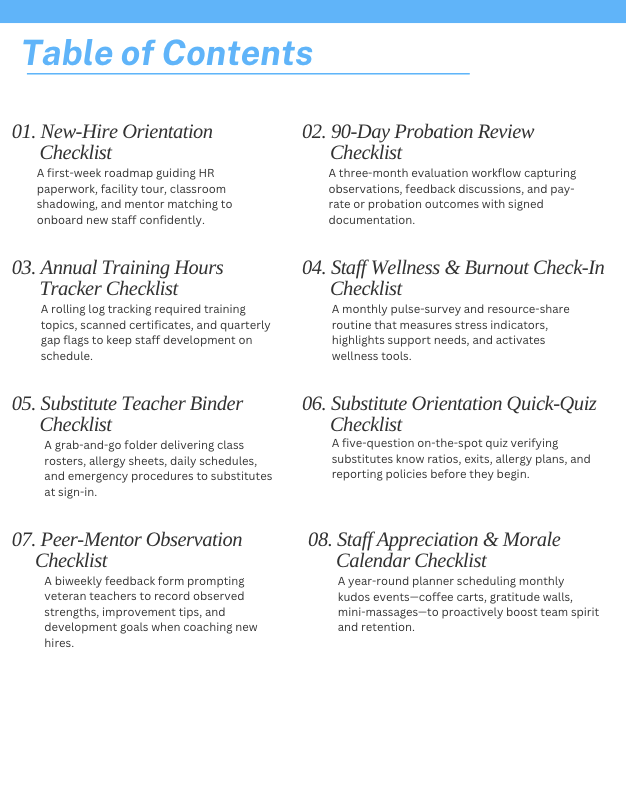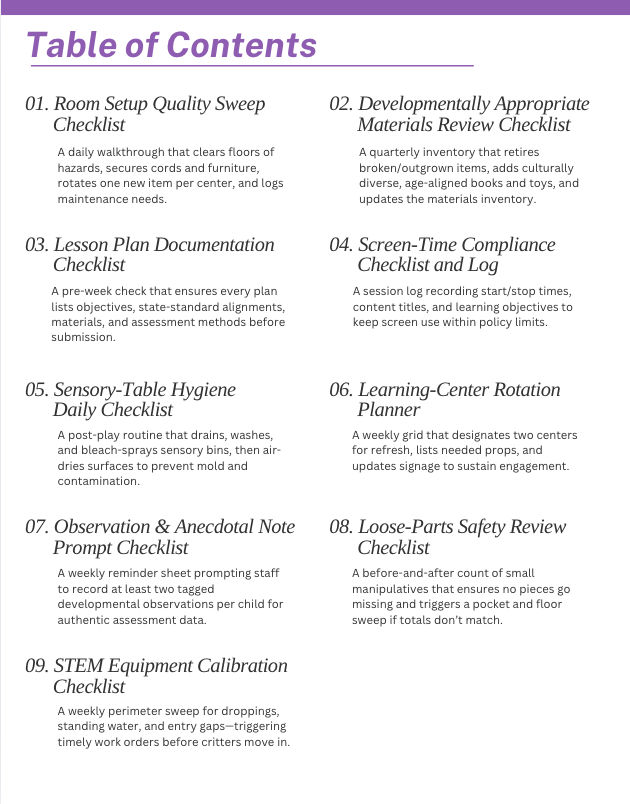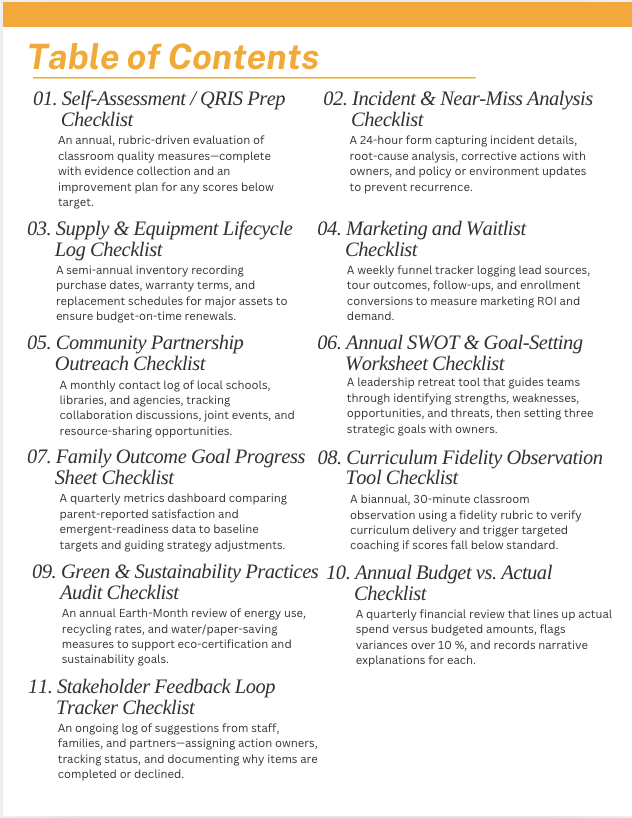Admin For You
SOP Series: The Complete Childcare Compliance and Quality Checklist Binder
SOP Series: The Complete Childcare Compliance and Quality Checklist Binder
Couldn't load pickup availability
SOP SERIES: The Complete Childcare Compliance and Quality Checklist Binder
Streamline every aspect of your center’s operations with this comprehensive, fully editable Canva binder. Inside you’ll find 100 detailed checklists and over a dozen bonus forms covering Health & Safety, Emergency Preparedness, Classroom Environment & Curriculum, Nutrition & Food Service, Staff Management & Professional Growth, Family Engagement, Inclusion & Special-Needs, Transportation, and Program Quality & Continuous Improvement.
From daily health screenings and diapering protocols to twice-yearly evacuation drills and annual SWOT planning, each checklist is formatted with clear headings, step-by-step actions, and signature/date lines so staff always know exactly what to do—and when. Simply drop in your logo, tweak any state-specific details, and share digitally or print on clipboards. One binder, zero guesswork—everything you need to keep kids safe, programs thriving, families informed, and regulators smiling.
What’s Included
1. Childcare Licensing & Administration Checklists
· Annual Licensing Renewal Checklist and Tracker: A four-month countdown that tells the director exactly when to pull forms, schedule inspections, update rosters, pay fees, and post the renewed license—so nothing gets missed.
· Annual Licensing Renewal Quality Control Review Checklist: A quick pre-submission audit: 24 items across data, staff files, inspections, and fees, signed off by a second reviewer to confirm the packet is 100 % complete and accurate.
· Daily Opening Checklist: A quick, room-by-room sweep that powers-up the building for the day: disarm the alarm, verify temperatures, restock essentials, spot any safety hazards, and get classrooms, kitchen, and playground ready before the first family walks in. The goal is a warm, safe, fully prepped environment by the time the doors open.
· Daily Closing Checklist: A structured shut-down that turns a busy center back into a clean, locked, and alarmed facility: sanitize high-touch areas, empty trash and diaper pails, log fridge temps, lock every door and window, and set the security system. It ensures nothing (and no one!) is left behind.
· Record-Keeping Compliance & Retention Quick Reference: A quarterly “paperwork check-up” that scans child, staff, and operational files against state retention rules, updating missing forms, archiving expired docs, and shredding outdated personal information so every record is audit-ready at any moment.
· Background Check & Fingerprint Checklist: A living log that sends each new hire for fingerprints, stores the clearance letter, records the 5-year expiration date, and triggers renewal reminders—so every adult on site is always background-cleared.
· Policy Revision Quarterly Checklist: A standing quarterly routine that scans new licensing bulletins, pinpoints affected policies, updates handbooks and emergency plans, secures board approval, and pushes the refreshed documents to staff and families, keeping everyone in lock-step with current regulations.
· Staff-to-Child Ratio Spot-Checklist and Log: A living log that sends each new hire for fingerprints, stores the clearance letter, records the 5-year expiration date, and triggers renewal reminders, so every adult on site is always background-cleared.
· Mandatory Poster & Notice Audit: A twice-a-year sweep that walks every room with the state poster checklist, replaces anything missing or faded, and files the signed list and receipts—so your walls (and your compliance file) are always inspection-ready.
· Technology & Data-Privacy Quarterly Audit: A once-per-quarter sweep that rotates shared passwords, checks device updates and Wi-Fi encryption, deletes expired child media, and purges old digital records—locking down every channel where children’s data lives.
2. Childcare Family Engagement Checklists
· Prospective Family Tour: A guided tour roadmap that delivers a consistent warm welcome, highlights safety features and curriculum, and logs family questions with next-step follow-up details.
· Enrollment & Transition: A step-by-step pathway from initial call and paperwork through classroom visit and first-week check-in, ensuring every enrollment milestone is tracked and documented.
· Parent-Teacher Conference Checklist: A structured meeting guide that organizes prep notes, goal-setting prompts, interpreter needs, and a follow-up action-item log for each conference.
· Daily Communication-App Audit: A weekly spot-check that confirms classroom posts include meals, naps, activities, and photos, and that all parent messages receive a response within 24 hours.
· Family Feedback & Satisfaction Survey: A twice-yearly survey schedule that times distribution, collects and analyzes scores, and triggers targeted action plans for any area scoring below 4 / 5.
· Family Event Checklist: An annual calendar that maps open houses, potlucks, and volunteer events, assigns task owners with due dates, and logs post-event debrief notes.
· Welcome-Packet Delivery Log: A delivery record that confirms each new family receives the handbook, key fob, and app instructions, with parent initials and staff sign-off for compliance.
· Home-Language Resource Referral Checklist: A referral tracker that logs non-English-speaking families’ languages, bilingual resources offered, acceptance status, and scheduled follow-up check-ins.
· Parent Volunteer Hour Tracker: A running log that captures volunteer names, activities performed, hours contributed, and prompts thank-you emails to acknowledge each family’s support.
· Drop-Off & Pick-Up Flow Audit: A quarterly timed audit of parking-lot and foyer traffic flows, identifies congestion or safety hazards, and documents signage or procedural tweaks for smoother routines.
· Family Resource Board Refresh Schedule: A monthly reminder that rotates community flyers, parenting tips, and workshop announcements on the lobby board, with a logged photo to verify each refresh.
3. Classroom Environment & Curriculum Checklists
· Room Setup Quality Sweep: A daily walkthrough that clears floors of hazards, secures cords and furniture, rotates one new item per center, and logs maintenance needs.
· Developmentally Appropriate Materials Review: A quarterly inventory that retires broken/outgrown items, adds culturally diverse, age-aligned books and toys, and updates the materials inventory.
· Lesson Plan Documentation Checklist: A pre-week check that ensures every plan lists objectives, state-standard alignments, materials, and assessment methods before submission.
· Screen-Time Compliance Checklist and Log: A session log recording start/stop times, content titles, and learning objectives to keep screen use within policy limits.
· Sensory-Table Hygiene Daily Checklist: A post-play routine that drains, washes, and bleach-sprays sensory bins, then air-dries surfaces to prevent mold and contamination.
· Learning-Center Rotation Planner: A weekly grid that designates two centers for refresh, lists needed props, and updates signage to sustain engagement.
· Observation & Anecdotal Note Prompt Checklist: A weekly reminder sheet prompting staff to record at least two tagged developmental observations per child for authentic assessment data.
· Loose-Parts Safety Review Checklist: A before-and-after count of small manipulatives that ensures no pieces go missing and triggers a pocket and floor sweep if totals don’t match.
· STEM Equipment Calibration Checklist: A monthly checklist verifying tablet updates, battery levels, scale zeroing, and complete part inventories for accurate STEM activities.
4. Childcare Inclusion and Student Special-Needs Checklists
· Individualized Care-Plan Review: An annual (or as-needed) meeting that verifies each child’s accommodations, therapies, medications, and parent consents are fully up to date.
· ADA Compliance Walk-Through: A yearly facility inspection checking door widths, ramps, restroom grab-bars, and playground surfacing for full accessibility.
· Behavior-Support Strategy Log Checklist: An ongoing ABC-style record of triggers, positive guidance strategies, child responses, and weekly team debriefs to refine behavior plans.
· Sensory Environment Audit: A twice-yearly scan measuring classroom noise levels, replacing flickering lights, and topping up sensory-corner supports to foster regulation.
· IEP/IFSP Team Communication Sheet: A structured log of meeting dates, service-provider contacts, goal progress, and next steps that keeps the entire team aligned.
· Assistive-Device Maintenance Log: A weekly checklist confirming cleaning, battery checks, and functionality tests for weighted blankets, visual timers, AAC tablets, and other adaptive tools.
· Cultural & Language Inclusion Checklist: A quarterly audit ensuring books, songs, labels, and displays reflect enrolled families’ cultures and home languages.
· Name-Pronunciation Roster: A living roster with phonetic spellings and optional audio clips that help staff pronounce every child’s name correctly.
· Cultural Holiday & Celebration Calendar: An August-set calendar capturing family-shared holidays and planning respectful classroom activities—and notifying families in advance.
· Inclusive Emergency-Evacuation Plan: A customized evacuation plan assigning buddies, mapping accessible routes, and drilling with special-needs equipment to secure safe exits for all children.
5. Childcare Health and Safety Checklists
· Daily Health Screening: A morning drop-off station that visually scans for coughs, rashes, or lethargy, takes a touchless temperature, and logs pass/fail results.
· Medication Administration: A six-rights protocol—child, drug, dose, time, route, documentation—with dual sign-off and parent notification for every dose.
· Diapering & Toileting Protocol: A hygiene-first routine guiding gloving, front-to-back cleaning, surface sanitizing, and thorough hand-washing after each change.
· Safe Sleep Audit (Infants): A crib-to-crib check ensuring firm, flat mattresses, back-only positioning, no loose bedding, and logged supervised tummy-time.
· Allergy & Special-Diet Quick-Glance Sheet: A single-page roster pairing child photos with allergen icons, diet notes, and EpiPen locations—posted wherever food is served.
· Hand-Washing Observation: A peer-audit that times 20-second scrubs, confirms soap/water availability and signage placement, and captures real-time coaching notes. Includes Bonus Hand-Washing Observation Log Sheet. Use this peer-audit form to time scrubs, confirm supplies/signage, and capture coaching feedback.
· Playground Weather Watch Checklist: A pre-play log recording heat index, wind-chill, and AQI so outdoor decisions are backed by data and defensible to concerned parents.
· UV-Sanitizer & Air-Purifier Maintenance Checklist: A monthly service tracker documenting lamp-hour readings, filter replacements, and exterior wipe-downs to keep equipment at peak efficacy.
· Pest-Prevention Walk-through: A weekly perimeter sweeps for droppings, standing water, and entry gaps—triggering timely work orders before critters move in.
· Sunscreen & Insect-Repellent Tracker: A seasonal authorization log that records parent consents, product brands, and exact application times to ensure safe outdoor play.
· Inside Walk-Through Safety Inspection: A room-by-room sweep that catches tripping hazards, loose furniture, blocked exits, and other safety red-flags before children arrive (or while they’re napping).
· Outside / Playground Walk-Through Safety Checklist: A quick but thorough perimeter check that makes sure the outdoor play space is free of debris, broken equipment, and environmental hazards before children head outside.
6. Childcare Emergency Preparedness Checklists
· Monthly Emergency Drill Checklist: A timed practice of fire, tornado, lockdown, and evacuation drills that records headcounts, exit times, and staff debrief notes.
· First-Aid Kit Inspection: A monthly audit verifying that each kit contains in-date bandages, meds, working flashlight batteries, and a signed inspection tag.
· Emergency Contact & Reunification Plan: A living roster ensuring up-to-date guardian phone numbers, approved pick-up designees, and off-site reunification maps are in every go-bag and office binder.
· Devolution of Control Sheet: A documented succession plan naming alternates, listing needed documents, and storing copies off-site to maintain leadership if primary staff are unavailable.
· Utility Shut-Off Map & Procedure: A color-coded diagram and step-by-step guide for gas, water, and power shut-offs, complete with vendor emergency contacts.
· Go-Kit (Evacuation Bag) Inventory: A quarterly check that confirms each evacuation bag holds current diapers, medications, snacks, water, and working flashlights within expiration dates.
· Alternate Communications Drill: A semi-annual test of radios or text chains that measures response times, identifies dead zones, and ensures backup communication works.
· Severe-Weather Shelter Condition Sheet: A biannual room check verifying flashlights, blankets, water, and quiet activities are in place for storm-season shelters.
· Staff Emergency Role Assignment Roster: A posted chart clarifying who handles attendance, first aid, and utility shut-offs, reviewed each semester to keep roles clear under pressure.
· Post-Incident Parent Notification Script: A template ensuring accurate, consistent family communications—covering facts, safety assurances, next steps, and reunification details after any reportable incident.
7. Childcare Nutrition and Food Service Checklists
· Meal Prep & CACFP Portion Checklist: Age-appropriate serving sizes, creditable food groups, and substitution tracking for reimbursements.
· Kitchen Sanitation Routine: Food-handler hygiene, three-step surface disinfection, fridge temps, and chemical‐storage rules.
· Menu Posting & Parent Communication: Weekly menu board, family email, allergen highlights, and three-year archive.
· Infant Bottle Handling: Label check, warming method, one-hour discard rule, and feeding log.
· Allergen-Safe Kitchen Zones: Color-coded utensils, top-shelf storage, and dedicated wipe-down procedure.
· Refrigerator & Freezer Deep-Clean Schedule: Monthly scrub of shelves, gaskets, drip pans, plus temperature-probe accuracy test.
· Farm-to-Table & Local-Produce Tracker Checklist: Records farmer name, delivery date, pounds, and dishes featured—for grants and newsletters.
· Water Pitcher Sanitizing Log (Classrooms): Twice-daily rinse, refill, bleach dip, and upside-down air-dry.
· Food-Allergy Emergency Drill: Quarterly mock reaction timing epi-pen retrieval, 911 call, and debrief notes.
· Leftover / Share-Table Monitoring Sheet Checklist: What’s placed, kept, or tossed to comply with health-department re-service rules
8. Childcare Transportation Safety and Compliance
· Vehicle Pre-Trip Inspection: A pre-route exterior and interior sweep checking tires, lights, fluids, seatbelts, child-check alarms, and emergency equipment before every trip.
· Passenger Count Verification: A four-step headcount at boarding, departure, arrival, and post-route sweep that guarantees no child is ever left behind.
· Driver Qualification File: An annual dossier containing current CDL, medical exam card, MVR check results, and in-service training records for every driver.
· Field-Trip Planning Form: A trip blueprint documenting destination approval, staff ratios, signed permission slips, emergency bag contents, and headcounts at every transition point.
· Seatbelt & Child Restraint Inspection Log: A monthly tug-test and visual inspection of each belt and child seat that checks for proper function and expiration compliance.
· Route Risk Assessment Sheet: An annual mapping of construction zones, flood-prone areas, and peak-traffic times with documented alternate routes and timing comparisons.
· Two-Way Radio Function Test: A pre-departure comms check where the driver verifies radio power, battery life, and a clear response from base before leaving.
· Emergency-Evacuation Drill (Bus) Log Checklist: A twice-yearly timed practice of front-door and rear-door exits with children, capturing evacuation times and behavior observations.
· End-of-Day Clean-&-Secure Checklist: A post-route routine that sanitizes high-touch areas, refuels if needed, logs mileage, inspects warning lights, restocks supplies, and locks all doors for next-day readiness.
9. Childcare Program Quality and Continuous Improvement Checklists
· Self-Assessment / QRIS Prep: An annual, rubric-driven evaluation of classroom quality measures—complete with evidence collection and an improvement plan for any scores below target.
· Incident & Near-Miss Analysis: A 24-hour form capturing incident details, root-cause analysis, corrective actions with owners, and policy or environment updates to prevent recurrence.
· Supply & Equipment Lifecycle Log: A semi-annual inventory recording purchase dates, warranty terms, and replacement schedules for major assets to ensure budget-on-time renewals.
· Marketing & Waitlist Tracker: A weekly funnel tracker logging lead sources, tour outcomes, follow-ups, and enrollment conversions to measure marketing ROI and demand.
· Community Partnership Outreach: A monthly contact log of local schools, libraries, and agencies, tracking collaboration discussions, joint events, and resource-sharing opportunities.
· Annual SWOT & Goal-Setting Worksheet: A leadership retreat tool that guides teams through identifying strengths, weaknesses, opportunities, and threats, then setting three strategic goals with owners.
· Family Outcome Goal Progress Sheet: A quarterly metrics dashboard comparing parent-reported satisfaction and emergent-readiness data to baseline targets and guiding strategy adjustments.
· Curriculum Fidelity Observation Tool: A biannual, 30-minute classroom observation using a fidelity rubric to verify curriculum delivery and trigger targeted coaching if scores fall below standard.
· Green & Sustainability Practices Audit: An annual Earth-Month review of energy use, recycling rates, and water/paper-saving measures to support eco-certification and sustainability goals.
· Annual Budget vs. Actual Checklist: A quarterly financial review that lines up actual spend versus budgeted amounts, flags variances over 10 %, and records narrative explanations for each.
· Stakeholder Feedback Loop Tracker: An ongoing log of suggestions from staff, families, and partners—assigning action owners, tracking status, and documenting why items are completed or declined.
10. Staff Management & Professional Growth Checklists
· New-Hire Orientation: A first-week roadmap guiding HR paperwork, facility tour, classroom shadowing, and mentor matching to onboard new staff confidently.
· 90-Day Probation Review: A three-month evaluation workflow capturing observations, feedback discussions, and pay-rate or probation outcomes with signed documentation.
· Annual Training Hours Tracker: A rolling log tracking required training topics, scanned certificates, and quarterly gap flags to keep staff development on schedule.
· Staff Wellness & Burnout Check-In: A monthly pulse-survey and resource-share routine that measures stress indicators, highlights support needs, and activates wellness tools.
· Substitute Teacher Packet: A grab-and-go folder delivering class rosters, allergy sheets, daily schedules, and emergency procedures to substitutes at sign-in.
· Substitute Orientation Quick-Quiz: A five-question on-the-spot quiz verifying substitutes know ratios, exits, allergy plans, and reporting policies before they begin.
· Peer-Mentor Observation Log: A biweekly feedback form prompting veteran teachers to record observed strengths, improvement tips, and development goals when coaching new hires.
· Staff Appreciation & Morale Calendar: A year-round planner scheduling monthly kudos events—coffee carts, gratitude walls, mini-massages—to proactively boost team spirit and retention.
Share
